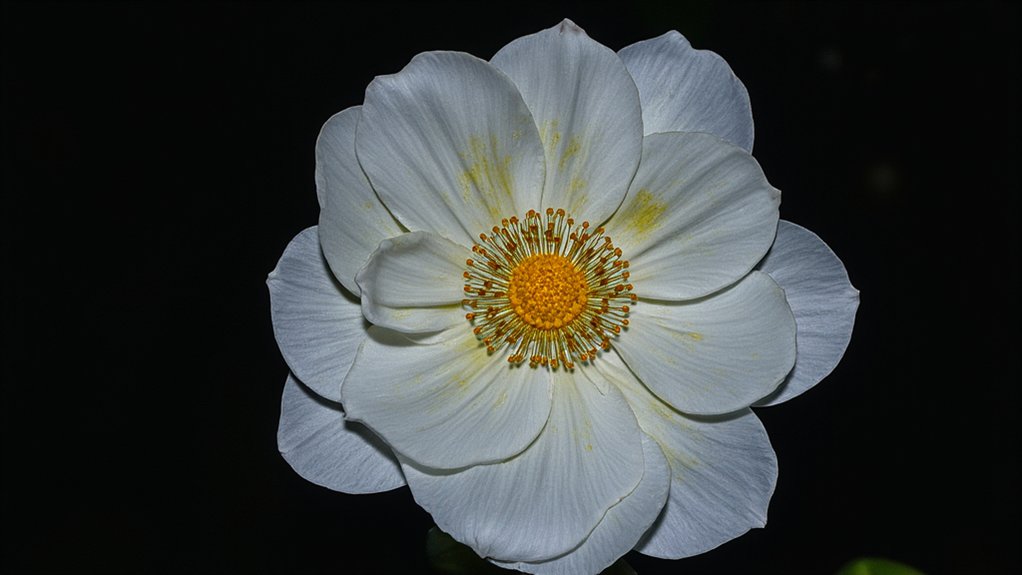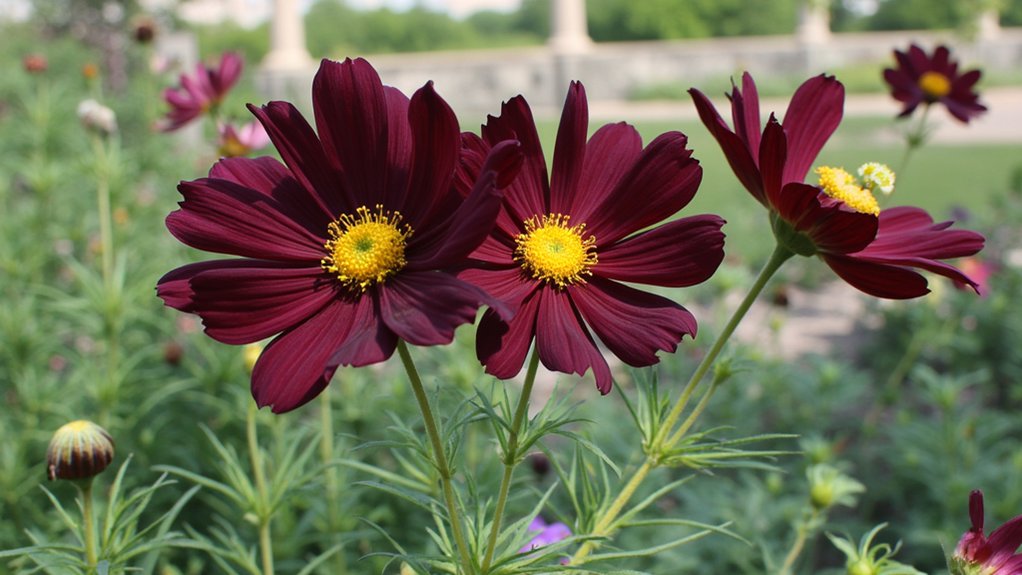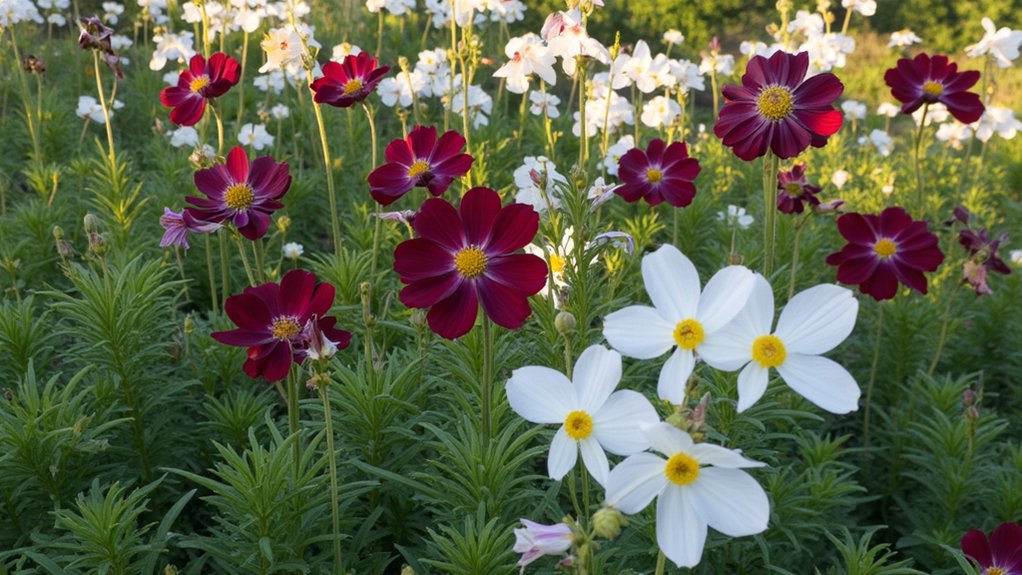You’ll discover that some plants can replicate the enticing aromas of your favorite desserts, from rich chocolate to smooth vanilla, right in your own backyard. These botanical mimics, which include specimens like Carolina allspice and chocolate cosmos, produce their distinctive scents through specialized chemical compounds in their flowers, leaves, and stems. While you might expect these fragrances only in a confectionery shop, nature has developed its own remarkable collection of sweet-smelling specimens worth exploring.
Contents
- 1 The Science Behind Plant-Based Scents
- 2 Sweet-Scented Stars: Chocolate and Vanilla Mimics
- 3 Candy Shop Favorites in Your Garden
- 4 Growing Conditions for Aromatic Plants
- 5 Creating a Dessert-Themed Sensory Garden
- 6 Unexpected Food-Scented Botanicals
- 7 Year-Round Fragrance Planning
- 8 Best Companion Plants for Scented Gardens
The Science Behind Plant-Based Scents

When plants produce their distinctive scents, they’re actually releasing volatile organic compounds (VOCs) into the air through specialized cells. These VOCs, made up of molecules like terpenes and esters, travel through the air and interact with your olfactory receptors.
You’ll find that temperature and humidity play vital roles in scent production. On warm days, you’re more likely to notice these fragrances as heat increases VOC volatility. Plants typically release these compounds for specific purposes: attracting pollinators, deterring predators, or communicating with nearby plants.
The concentration of VOCs varies throughout the day, with most plants releasing peak amounts during mid-morning hours.
Sweet-Scented Stars: Chocolate and Vanilla Mimics

A fascinating group of plants has evolved to produce scents remarkably similar to chocolate and vanilla, despite having no genetic relation to cocoa or vanilla orchids. You’ll find this remarkable mimicry in species like the Carolina allspice (Calycanthus floridus) and chocolate cosmos (Cosmos atrosanguineus).
The chocolate daisy (Berlandiera lyrata) releases its rich cocoa scent each morning, while chocolate mint’s dark stems carry both mint and chocolate notes. For vanilla lovers, don’t miss the California mountain iris (Iris douglasiana) or the heliotrope (Heliotropium arborescens), which produces vanilla-like fragrance throughout summer.
Candy Shop Favorites in Your Garden

Creating your own candy shop garden becomes remarkably simple with these dessert-scented favorites. You’ll want to start with Carolina allspice, which produces brown flowers that smell like bubble gum when crushed, and chocolate cosmos, featuring deep burgundy blooms with a rich cocoa scent.
Don’t forget to include chocolate mint, easily grown in containers to control its spread. Plant it 18 inches apart in well-draining soil, and you’ll enjoy its sweet aroma all season. For a finishing touch, add chocolate flower (Berlandiera lyrata), which releases its distinct chocolate fragrance in the morning hours between 6 and 10 AM.
Growing Conditions for Aromatic Plants
Since aromatic plants produce their strongest scents in ideal conditions, you’ll need to get their growing environment just right. Most chocolate and vanilla-scented plants thrive in well-draining soil with a pH between 6.0 and 7.0, and they need at least 6 hours of daily sunlight.
Maintain consistent moisture levels, but don’t overwater. These plants prefer humidity around 50-60%, which you can achieve by misting or using a humidity tray. Keep temperatures between 65-75°F during the day and no lower than 55°F at night.
Feed your aromatic plants monthly with a balanced, water-soluble fertilizer (10-10-10) during the growing season.
Creating a Dessert-Themed Sensory Garden
Now that you’ve mastered the growing requirements, let’s build an enchanting garden space that delights both nose and eyes. Start by sketching a 6×8 foot plot, dividing it into three distinct zones for chocolate, vanilla, and caramel-scented plants.
Position your Carolina allspice and chocolate cosmos in the back zone, where they’ll grow 3-4 feet tall. Plant vanilla-scented heliotrope and chocolate mint in the middle section, spacing them 12 inches apart. For the front border, add clusters of chocolate daisy and vanilla grass, keeping them 8 inches from the path’s edge.
Unexpected Food-Scented Botanicals
While chocolate and vanilla scents steal the spotlight in fragrant gardens, you’ll find several surprising plants that mimic familiar food aromas. The pineapple sage releases a tropical fruit scent when you brush against its leaves, while crown imperial fritillaria oddly smells like garlic.
You’ll discover that anise hyssop’s leaves produce a distinct licorice fragrance, and the kaffir lime tree’s foliage gives off a citrusy, spicy scent. Don’t overlook the strawberry-scented leaves of the mock strawberry plant or the curry plant’s warm, spicy aroma that intensifies in summer heat.
Year-Round Fragrance Planning
To maintain a fragrant garden throughout all seasons, you’ll need to carefully select and position plants that bloom or release scents at different times of the year. Create a bloom calendar that maps out peak fragrance periods for each plant, ensuring continuous aromatic coverage.
Start with early spring bloomers like chocolate cosmos and vanilla primrose, then shift to summer performers such as chocolate mint and vanilla heliotrope. For autumn, include chocolate dahlias and vanilla-scented clematis. During winter, rely on witch hazel and winter honeysuckle for subtle sweet notes.
Place these fragrant specimens near walkways and seating areas, spacing them 2-3 feet apart for ideal scent dispersal.
Best Companion Plants for Scented Gardens
Beyond spacing your chocolate and vanilla-scented plants effectively, selecting the right companion plants amplifies their aromatic impact. Consider pairing chocolate cosmos with lavender or rosemary, which create complementary scent layers while requiring similar growing conditions.
For vanilla-scented heliotrope, you’ll want to add sweet alyssum or garden phlox nearby, as they’ll bloom at different heights and extend the fragrant season. Plant them 12-18 inches apart to prevent overcrowding.
Don’t forget structural elements like ornamental grasses, which help disperse scents and provide visual contrast. They’ll also protect your fragrant plants from strong winds that can dissipate their appealing aromas.
